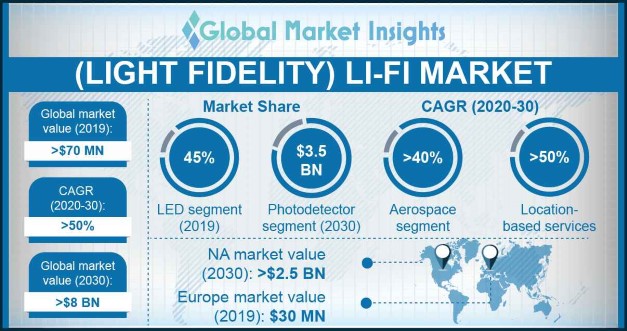Home > Semiconductors & Electronics > Telecom and Networking > Telecom Hardware > Li-Fi Market
Li-Fi Market Size
- Report ID: GMI462
- Published Date: Jun 2020
- Report Format: PDF
Li-Fi Market Size
(Light Fidelity) Li-Fi Market size exceeded USD 70 million in 2019 and is poised to grow at a CAGR of over 50% between 2020 and 2030. Rapidly increasing smartphone penetration coupled with growing consumption of data will drive the market growth.
Increasing utilization of connected devices in business establishments has led to a growing demand for indoor distributed networks. Indoor wireless connectivity through Li-Fi enables business users to make calls, send & receive email, and access the internet at high speeds. The ability of Li-Fi to transfer high volumes of data without any interference from existing radio frequencies will augment the market demand.
The growing trend of implementing Li-Fi technology in applications such as healthcare and security is providing a positive outlook for the market. It is encouraging government authorities to invest in R&D initiatives to spur the industry growth.
One of the major factors hampering the Li-Fi market growth is the high implementation cost. The enhanced performance of these systems is achieved through high-power LEDs, photodetectors, and microcontrollers. The high cost of these components adds up to the overall cost of Li-Fi systems, impacting their demand. Moreover, the complex architecture of these systems requires the services from trained professionals for installation and maintenance, thereby challenging the industry growth. However, market players are focusing on reducing the production cost of Li-Fi components to encourage its commercialization.
| Report Attribute | Details |
|---|---|
| Base Year: | 2019 |
| Li-Fi Market Size in 2019: | USD 70 million (2019) |
| Forecast Period: | 2020 to 2030 |
| Forecast Period 2020 to 2030 CAGR: | 50% |
| 2030 Value Projection: | USD 8 Billion (2030) |
| Historical Data for: | 2016 to 2019 |
| No. of Pages: | 209 |
| Tables, Charts & Figures: | 206 |
| Segments covered: | Component, Application |
| Growth Drivers: |
|
| Pitfalls & Challenges: |
|
The outbreak of COVID-19 health crisis in January 2020 has led to a slowdown in the growth of market, posing several industry challenges. Disruptions in supply chain and restrictions on movement have impacted international trade. This has caused a disturbance in manufacturing and business operations of industry players, hampering the market revenue. Moreover, increasing consumer inclination towards purchasing essential commodities is expected to restrict the adoption of new technologies such as Li-Fi, impacting the market size in 2020.

